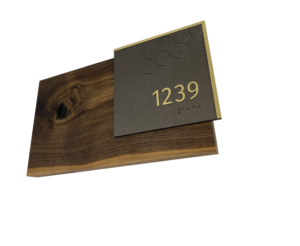
In 2024 federal ADA sign requirements apply to everything from bathroom and restroom signs to accessible elevator signs and room signage. Because legal regulations can be confusing, we’ve compiled easy to understand ADA sign compliance FAQs.
Federal ADA sign requirements apply to all U.S. jurisdictions. Some state and local jurisdictions have codes and legal requirements in addition to what’s covered here. Jurisdictional additions are typically minor. Because interior ADA signs requirements vary, when in doubt contact your local building inspector to confirm ADA signage compliance.
To get all federal ADA sign requirements information in one place download our ADA Sign Requirements Guide. This comprehensive Guide contains easy to understand diagrams and is a great resource for all members of your team that work with ADA room sign design and installation.

“ADA signage” refers to signs marking building rooms, spaces or features as required by U.S. federal law. In 1990 the Department of Justice published the Americans with Disabilities Act (ADA) in order to prohibit discrimination against those with disabilities. ADA sign requirements enforced today were released as part of the 2010 ADA Standards for Accessible Design (SAD).
The terms “braille sign”, “tactile sign”, “accessibility signs”, and “accessible signage” often refer to interior ADA signs and exterior signs that include raised letters and braille. In addition to tactile braille signs, the ADA and SAD also define and require signs with flat characters.
This hexagon custom door sign is made of 1/2 inch aspen wood with a shallow 45 degree edge bevel, black raised letters and clear braille.
Generally, interior ADA signs are required at every doorway in all U.S. public buildings, including b usinesses, apartments, offices and even home businesses with visiting clients or employees. In addition to doorways, ADA signage is sometimes required at other interior and exterior building locations.
The size of an establishment does not provide an exemption from federal regulations. If you own or manage a small business or building and have employees, clients or customers, you must follow comply with federal ADA signage law. Only prisons and buildings eligible for the National Register of Hi storic Places do not need to comply with ADA sign requirements.
We sometimes hear from clients surprised to learn that ADA signs are required at more than restroom doorways. In the past, this was often the only ADA sign requirement enforced by local inspectors, especially for small businesses. Unfortunately, this led to a misconception in some areas of the U.S. that ADA sign codes only apply in certain scenarios. The fact is, federal law requires tactile, raised character signs at every doorway.
ADA sign requirements apply in the following types of buildings:

While not all signage is regulated by the ADA, many building signs are covered by federal regulations.
Per SAD §216, ADA compliant signs serve three primary purposes:
Specific requirements for the following sign types are included in the SAD.
Exit signs – Exit passages, including doors, stairs and routes, must be identified with tactile ADA signage. Signs must include braille and raised characters. Pictograms are optional. While understanding which doorway should be marked “exit” is pretty easy, be sure to mark any decision point on an egress pathway, such as a corridor, with a tactile “exit route” sign.
Area of refuge signs – A reas of refuge must be marked with tactile ADA signage. Signs must include braille, raised characters and the ISA pictogram. If an illuminated exit box is required, a lit area of refuge sign must also be used.
Area of refuge instructions – Areas of refuge must also contain signage with instructions that direct persons on actions to take during an emergency. Area of refuge instructional s ignage must meet ADA visual character requirements, however, raised content and p ictograms are optional.
Signs for devices assisting the disabled – Signs identifying Text Telephones, Assistive Listening Systems and Volume Control Telephones must meet ADA visual character sign requirements.
Inaccessible building elements – Inaccessible entrances, elevators and restrooms must have directional signage indicating the location of the nearest handicapped accessible entrance, elevator or restroom. Signs directing to accessible spaces must meet ADA visual character requirements. Braille and pictograms are not required in directional signage. The ISA is required at the accessible entrance, elevator or restroom if not all entrances, elevators or restrooms are accessible. In California, the ISA is required at all accessible entrances whether or not a facility has entrances which are not accessible.
Other required ADA signs – At handicapped accessible check-0ut aisles and accessible amusement park ride access points, ADA signage with the ISA is required.
Required outdoor ADA signs – While almost all ADA sign requirements focus on indoor signage, a few exterior ADA signs are also covered by regulations. If the exterior doorway is used to access bathrooms, classrooms, courtyards and other similar spaces, the doorway must be marked with tactile ADA signs.
Federal ADA sign requirements apply to U.S. public buildings’ permanent signage. Changeable and temporary signs, including menus and directories, are not required to meet regulations. Temporary signs are defined as in use for six weeks or less. Additionally, custom signs that enhance branding, such as organization name and logo signs, are not regulated. Finally, in correctional facilities, signage not in public areas, such as prisoner unit identification signs, do not need to comply.
Most interior ADA signs are hung about 54 inches above the floor and with their center 9 inches away from the door, on the door handle side of the doorway. This location complies with ADA sign requirements and works for the vast majority of signs.
As specified in SAD §703.4.1, ADA sign height must be between 48 inches and 60 inches, measured from the floor to the baseline of the tactile characters. This 12 inch range of allowable sign hanging height lets signs of varied size to be consistently installed on the same visual line along a wall. Often, it works well to hang all ADA and wayfinding signs 54 inches from the floor to the bottom of all signs.
Additionally, SAD §703.4.2 details the two location requirements that are most common for ADA signs. When a braille sign is provided at a door, it must be mounted on the latch side of the door. Signs with tactile characters should be centered in a clear floor space of at least 18 inches by 18 inches. Commonly, this means you should center tactile characters 9 inches from the door edge. The clear floor spacing must be beyond the arc of the door swing between the closed position and open position.
Note that California ADA sign height regulations are 48 inches to the bottom of the braille, making the allowable mounting sign installation height range about 3/4 inch narrower.